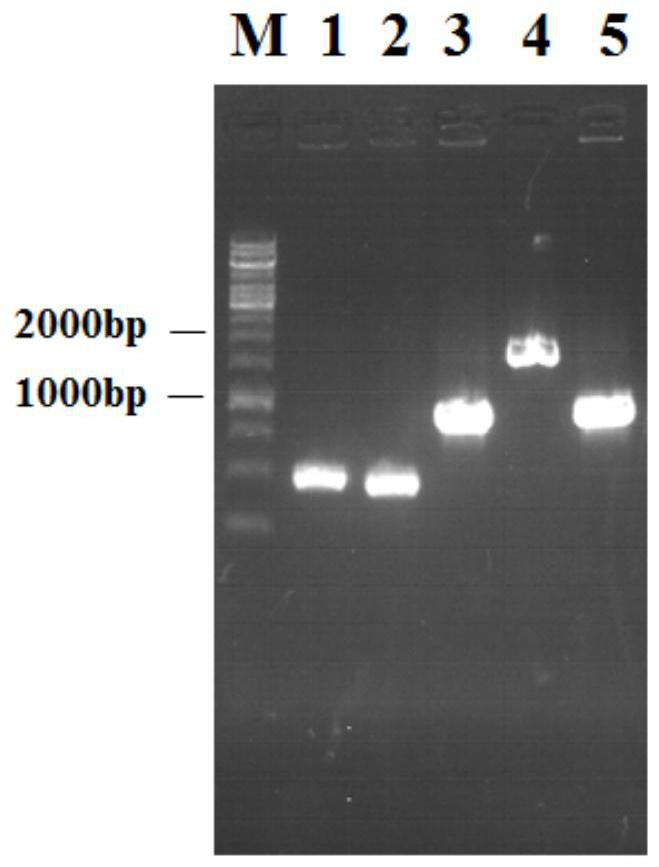A kind of genetically engineered bacteria producing n-acetylglucosamine and its application
A technology of genetically engineered bacteria and acetylamino, which is applied in the field of genetically engineered bacteria producing N-acetylglucosamine, can solve the problems of strong acid waste liquid polluting the environment, strong hydrolysis conditions, and crowd allergies
- Summary
- Abstract
- Description
- Claims
- Application Information
AI Technical Summary
Problems solved by technology
Method used
Image
Examples
Embodiment 1
[0108] Construction of E.coli W3110-GLA-1 strain
[0109] (1) Knockout of nagBAC gene cluster:
[0110] Using CRISPR / Cas9 gene editing technology to knock out the nagBAC gene cluster:
[0111] ①Using PCR technology to use the E.coli W3110 genome as a template, according to the nagBAC gene sequence, design upstream homology arm primers (nagBAC-UF / UR) and downstream homology arm primers (nagBAC-DF / DR) at both ends of the gene, PCR Amplify and obtain the upstream and downstream homology arms of the nagBAC gene;
[0112] ②Using overlapping PCR technology to use the upstream and downstream homology arms of the nagBAC gene as templates, PCR amplification was used to obtain the overlapping fragments of the upstream and downstream homology arms of the nagBAC gene;
[0113] ③ Construct a gRNA plasmid containing the Cas9 cleavage recognition sequence. The DNA fragment containing the target sequence is obtained by annealing the primers nagBAC-F and nagBAC-R. The constructed gRNA plasmi...
Embodiment 2E
[0161] Embodiment 2E.coli W3110-GLA-1 bacterial strain 5L fermentation tank fermentation experiment:
[0162] The E.coli W3110-GLA-1 strain constructed in Example 1 is used as a production strain to ferment and produce N-acetylglucosamine:
[0163] (1) Slope activation culture: Scrape a ring of bacteria from the -80°C refrigerator bacteria preservation tube, evenly spread on the activation slope, culture at 37°C for 12 hours, transfer to the second generation slope culture for 12 hours;
[0164] Seed culture: Aseptic operation, take appropriate amount of sterile water on the second-generation activation slope, put the bacterial suspension into a 5L fermenter with 3L seed medium, and control the automatic flow of ammonia water through the pH electrode to maintain the pH during the cultivation process Stable at around 7.0; the temperature of the fermentation process is automatically controlled at 37°C by the temperature electrode; the dissolved oxygen is controlled between 25-35...
Embodiment 3E
[0171] Embodiment 3E.coli W3110-GLA-2 bacterial strain 5L fermentation tank fermentation experiment:
[0172] Use the constructed E.coli W3110-GLA-2 strain as the production strain to ferment and produce N-acetylglucosamine:
[0173] (1) Slope activation culture: Scrape a ring of bacteria from the -80°C refrigerator bacteria preservation tube, evenly spread on the activation slope, culture at 37°C for 12 hours, transfer to the second generation slope culture for 12 hours;
[0174] Seed culture: Aseptic operation, take appropriate amount of sterile water on the second-generation activation slope, put the bacterial suspension into a 5L fermenter with 3L seed medium, and control the automatic flow of ammonia water through the pH electrode to maintain the pH during the cultivation process Stable at around 7.0; the temperature of the fermentation process is automatically controlled at 37°C by the temperature electrode; the dissolved oxygen is controlled between 25-35% by the rotati...
PUM
 Login to View More
Login to View More Abstract
Description
Claims
Application Information
 Login to View More
Login to View More - R&D
- Intellectual Property
- Life Sciences
- Materials
- Tech Scout
- Unparalleled Data Quality
- Higher Quality Content
- 60% Fewer Hallucinations
Browse by: Latest US Patents, China's latest patents, Technical Efficacy Thesaurus, Application Domain, Technology Topic, Popular Technical Reports.
© 2025 PatSnap. All rights reserved.Legal|Privacy policy|Modern Slavery Act Transparency Statement|Sitemap|About US| Contact US: help@patsnap.com



